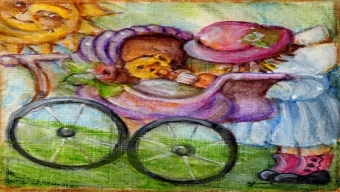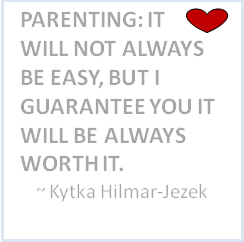Ask Kytka Archives: August 1, 1999
Q: Would you tell me something more about children’s toys?
A: I wouldlove to as this is one of my most favorite subjects!
Toys that Teach: A Lesson in Reverence, Gratitude and Beauty
A toy is something your child invests precious time in and in this way it acts as a teacher. The right toy can teach your child to care, to be watchful and conscious, to be careful, to appreciate, to love. In your child’s hands are the keys to learning to be grateful, to appreciate beauty, to have a sense of peace and reverence for life in all its forms… By the same token, the wrong toys can teach your child anger, frustration, disregard, insult and mockery. How many times have you seen this at the community playground? Children mimicking the grotesque objects they have been playing with? Making grimaces and bullying the other children. They are putting out what they have taken in, from their toys.
What can a plastic contraption possibly teach your child? What lesson is hidden within the action figure? When children have a room full of such toys they are often so overwhelmed, that they choose not to play at all. Grandparents come and say they are spoiled. Oftentimes, when they do choose to play, they play in a very aggressive and destructive manner. They show no sense of love or caring for these toys. They show no gratitude for these toys. These toys which growl at you and make grimaces at you seem to be designed to instill or teach anger, frustration, and hatred. Ask yourself “what does my child get from such a toy?” If you closely observe your child you will discover that their play lasts about 5 minutes at most and they end up being frustrated and overwhelmed. They physically look ill after playing this way, with these toys.
The reason for this is that children take everything from their play and it becomes a part of who they are and who they are about to become. Children internalize everything from {+++} their surroundings. When they are exposed to synthetic and ugly toys, children are at risk of losing their sense of awe, their sense of reverence and beauty. They begin to internalize the messages that these toys put forth: Hit, Stomp, Slam, and Pound, Throw away. Replace. These feelings then grow within our children. Their relationships become “synthetic” and their play grows ugly.
These children then grow into teenagers who bulldoze through and over their fellow teens. They have grown up to think that just about anything can be replaced. Everything is meant to be handled roughly and without special care. They grow up with fast food and throw away drive-through toys, which mean nothing to them. They blaze through the world without worrying about what gets stepped on or knocked over, believing it can all easily be replaced or that it is the responsibility of everything in their way to be strong enough to last. They break their plastic battery operated gizmos and into the garbage it goes. Sadly, in our mass produced society, it often quickly gets replaced with one exactly like it. What does that teach our child?
Many parents do not realize that the mind of a developing child takes in everything. These toys have very negative impact on our children and their behavior changes from inherently good and loving to bad and spiteful. The young child learns the most when at play. Play is the work of the child and it is through play that the child learns to be an adult. Why then are we not more careful and more aware when we choose our children’s playthings?
The majority of modern toys do not speak to the soul of the child. In this way they can actually damage the child. They not only rob the child of his/her imagination and sense of wonder, but they create a shell over the child’s heart. The toys of today are “dead”. Obviously, they are not beautiful. They have no energy coming from them. They are just… ugly. Don’t our children, who only recently arrived and are still so intertwined with the spiritual world, deserve better?
In looking at the writings of Rudolf Steiner, founder of the Waldorf Schools, we discover that the first seven years of life the child should see and experience the world as a place of goodness. The child in this age group learns primarily through imitation. Teachers trained in the Waldorf Education method are taught to be completely conscious of each and every movement, because they know they child takes it all in – good or bad. Waldorf Kindergartens are places of simple beauty for this reason. Children from ages 7 through the onset of puberty should experience the world as a place of beauty, because through beauty they will gain a reverence for life, which they will carry through to their adult lives. The Waldorf method of education is based completely on these beliefs.
Children need to have a few simple toys, ones that must be delicately cared for and lovingly attended to. They require toys, which they can wash by their own hand, hang in the air to dry and gently fold. They blossom when playing with toys, which need to be carefully polished, and which can be mended. They thrive when they have toys, which they know they will pass along to their younger siblings. It is through this that they learn to have gratitude, reverence, and a sense of beauty for their environment and surroundings. The majority of modern toys simply do not speak to the soul of the child.
Which toys do speak to the child? Silks, Woods, Nuts, Shells, Seeds, Stones, Crystals, Leaves, Ribbons and little baskets in which to carry their treasures. These are the types of toys, which speak to the child’s soul. These Natural Wonders instill awe and discovery, magic and wonder in your child. These toys have been created as “one-of-a-kind” treasures. These toys are special and can become just about anything your child imagines them to be.
Consider pure silk scarves for play. They are delicate and ethereal and they seem to naturally awaken that sense of awareness of beauty and reverence. They awaken the child’s imagination and inspire their creativity. Children appreciate their simplicity, and yet take such wonder in the magic that a simple little cloth can be transformed into so many wonderful things.
Wood is another example. It comes from a living, growing organism and has so much potential. Has this wood been carved or “decorated” by the creatures of the forest? What sort of tree did this wood come from? Imagine that two pieces of wood will never be exactly the same and your child can feel this and sense it when holding this toy. What a lesson of gratefulness for this piece of wood – which is here play with. What a wonderful discovery when playing outside your child finds this wonderful toy all by him or herself… as it was meant to be! Your child will carry this wood as a parcel, build with it as a block, cradle and hold it as a baby. This piece of wood can be turned into just about anything in the imagination of your child. Perhaps grandfather can carve this little wood into an animal friend, or a gnome to return to the garden.
Such treasures are not easily replaced. If you are not careful and you break a wooden toy (especially a hand made or found one) it is truly a tragedy because it is a one of a kind. If the child is lucky it can be repaired and will be cared for even more delicately because it has been weakened. Of course, this will make the toy be loved and cherished all the more for the wounds it bears and the effort that went into saving it.
The children of today have adopted many of their attitudes in life because of the toys they have been surrounded with in their childhood. The mass produced disposable toys of today are wasteful, ugly and harm not only our children but also our environment. They are impersonal and created for one purpose and one purpose only -–to make money for their creators. The next obvious reason is for them to break and be replaced easily, teaching your child to want more…
Remember, the toy your child is holding is your child’s teacher today.
It’s up to you to decide which lesson your child will learn today by the toys you provide.
Update October 2002 – Knowing Parents Speak Out:
Parent One: As far as the toys go, I went through a similar situation with my now 15-yo. When he was younger, he had a VERY difficult time letting go of his ‘old’ stuff. One idea you might try is to rotate his toys. Put about half of them up in the closet, in boxes, etc., out-of-sight. Let him know what you are doing and that he can play with the items that are out, then every 3-6 months, you can rotate the stuff again. Or just do what works for you. My now 5 year old is better at ‘giving’ stuff away to charity and what-not and more willing to let go of ‘things’ (also a totally different temperament!). You might try talking with your son about any thing you might want to give to a charity, church Sunday school group, or whatever. This type of reasoning may take a while to set in, but after a number of years, he may be willing to part with some things. We now regularly ‘purge’ and give stuff to charities. (I really love to get rid of stuff in an effort to live more simply!)
Parent Two: I am also the mother of a first grandchild and we have also struggled with the overwhelming amount of stuff. But, he’s now 7 and I also have an almost 4 year old and a 7 month old baby and I’m beginning to feel like I’ve got a handle on it. For awhile I tried to do the purge and get rid of the plastic and replace with beautiful wooden toys. But we have a significant gift-giving non-Waldorf side of the family, so we get lots of stuff that is very un-Waldorfy. Ultimately, I decided that it just didn’t feel good to me to not be thankful for even those toys that were not what I would choose. My children still loved the gifts and always expressed their gratitude and it just didn’t feel right to counter that with my desire to purge. So, I am sorry to admit, I am a Waldorf teacher whose child has a Buzz Lightyear doll on the top shelf of his closet. I’ve thought about getting rid of it (along with the LeapPad book, the LiteBrite and the video game-like car game) but when these toys do come out (and off the out-of-reach top shelf) the children always remember who they came from and they are truly grateful. We did go through a period where we just had too much, but then something would break or pieces would get lost, and out it would go. The gift giving has slowed WAY down, and the relatives have started concentrating on other kinds of gifts — sporting goods for my 7 year old, clothing for all the kids, money for their college funds. And, believe it or not, my youngest child only has one toy that was bought specifically for him, given by a friend. So now the toys are at a manageable number. My next step is to involve the children in their care. Now that we don’t have so much, the children can really focus on what they have and learn to take care of it.
Anyway, my whole point here, is that the gratitude issue could be the children picking up on your own feelings about the toys. If you yourself don’t feel grateful and appreciative of the toys that your children are given, they won’t feel that gratitude themselves.
Parent Three: I used to beat myself up for not keeping a “Waldorf home.” Whatever that is. The toys that haven’t come from me, the plastic or brand or electronic ones – the kids get bored with them (and don’t think I don’t encourage that…”Yup, H, that’s what that button does – it makes the doggie woof. You can press it again, and guess what? It will do the same thing!”) BORING. So I don’t fret. I trust that my children know good from bad toys because their instincts and experience tell them to differentiate. And they, too, USUALLY remember who bought them what and I do know they are, if not outright grateful, then at least conscious. And that has value, that consciousness.
We Waldorf or Waldorf-inspired parents are awfully hard on ourselves, I think. I lead by example, cook healthy, whole, nutritious foods, include my child in my day in a conscious, loving, way, meet their growing needs, send them to a well-picked school, enrich their lives with baking, crafts, toys, art, music. I could go on and on. I can’t do it all, 100% perfectly, all the time. Occasionally we watch TV, but when the show is over it’s my son who gets up to turn it off, preferring to go play after he’s been sitting for 30 minutes.
Then again, he’s a special kid. Last night we were driving down the big hill towards Puget Sound on our way home, and the sun was breaking through the clouds sending shafts of light upwards. “Look honey,” I said, “isn’t that beautiful?” “Mmm-hmmm, it looks like all of love.” Pause. “Gee, that’s funny, I’ve never seen love out of our bodies before.” He kills me, that son of mine. Meanwhile the baby’s in the back babbling with his fist in his mouth and it was a perfect day.
* Special Thanks to all those who shared!
Play Clip Questions and Answers
Does anyone know where I can get replacement fat rubber bands for my daughter’s wooden play clips? Over time, the original bands have frayed and turned limp (also choking hazard for my crawler) but the only ones I find in the correct width are also way too long, like for big bulk mailings or something. Any clues or ideas for improvising appreciated!
“What about the fat rubber bands that come on a bunch of broccoli? Those are pretty wide but not too big.” ~Cyndi
“Maybe the rubber bands that come around bunches of broccoli?”
“I always replace mine with the wide short bands that heads of broccoli come bound in. They usually say organic but other than that work great! ~Melody





















